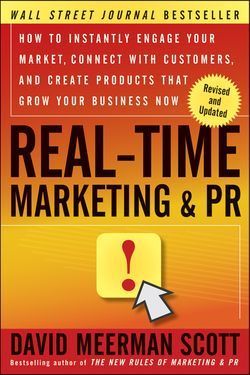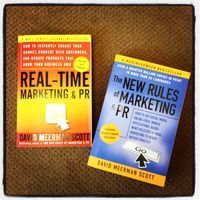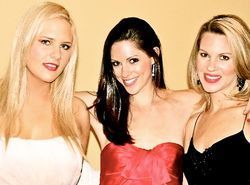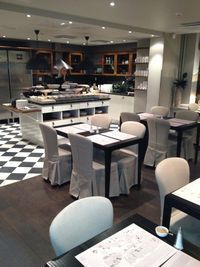David Meerman Scott's Blog, page 89
January 10, 2012
How to lose $2400 in 24 seconds (and get it back from B&H via Newsjacking)
When Kurtis Hough was filming a video on Cannon Beach, Oregon using a tripod with his $2,400 Canon 5D Mark II DSLR camera, he didn't expect that a storm surge would destroy it in just 24 seconds.
Fortunately his memory card was fine so he posted the resulting video which now has more than 1.5 million views.
Direct to How to lose $2400 in 24 seconds on Vimeo.
What surprised Hough even more than trashing his camera was when B&H Photo-Video, a NYC based retail and mail order retailer, stepped in to replace it at no cost. (Hough was an existing B&H Photo-Video customer).
Newsjacking.
A big story in the photography world becomes a perfect opportunity for a camera retailer to show support to a customer.
 I connected with Henry Posner, Director of Corporate Communications for B&H Photo-Video to learn more about his newsjacking success.
I connected with Henry Posner, Director of Corporate Communications for B&H Photo-Video to learn more about his newsjacking success.
"A couple of guys here found the original video on Vimeo which by then had 500,000+ views in 24 hours or so," Posner told me. "We shared it among ourselves for our own amusement because we're all photographers on one level or another and each of us felt the guy's pain. Then, we figured out that Hough was a customer and in fact had bought other Canon gear from us less than a year ago. That's when we began exploring replacing the camera and getting management on board to shoulder the price."
The B&H Photo-Video team reached out to Hough and made the offer. Soon Hough was talking up the camera replacement in television and print interviews.
"The response of the newscasters at the very end of the Right This Minute story is a strong indication of how this has been received," Posner says. "The buzz was fantastic and we were both glad to help Kurtis and excited to be part of and to have shaped the story."
In comments on photo blogs and the media stories, some people pointed out that B&H Photo-Video was offering the free camera as an inappropriate self-promotion. However, many others commented back to praise the company for helping Hough.
Posner's own reply in one of the forums told the company's side of the story: "Of course we did it in no small part for the advertising/publicity," he says. "We could have taken the same money and bought more pages in the back of PopPhoto or more air time on WCBS-AM, but in our opinion this was a far more useful way to spend that money. We did a guy who had a loss a favor and we got some PR for doing it. We're not a charity and we didn't do this for entirely altruistic reasons. But I'm glad we did it, glad the guy's got a new camera and glad it's generated the conversation it has."
This story illustrates once again the incredible power of Newsjacking.
Learn more about Newsjacking here.
January 9, 2012
real time + marketing = revolution
 This week, the new paperback edition of Real-Time Marketing & PR: How to Instantly Engage Your Market, Connect with Customers, and Create Products that Grow Your Business Now is out.
This week, the new paperback edition of Real-Time Marketing & PR: How to Instantly Engage Your Market, Connect with Customers, and Create Products that Grow Your Business Now is out.
The book was originally published in November 2010 in hardcover, and this edition is revised and updated with new stats and new examples.
As I was writing the first edition, I felt like a lone voice in the wilderness. Every time I searched the web for talk about issues relating to real-time marketing and PR, results were scarce. Pundits and practitioners seemed locked into thinking about long-term campaigns and not how to seize advantage from what's happening right now.
More than a year later, search engines tell a very different story: "real time + marketing" is a topic that has exploded. Even the Direct Marketing Association is in the game. The DMA annual conference, one of the largest gatherings of marketing professionals in the world, is now billed as "The Global Event for Real-Time Marketers."
What happened?
Although my humble book did climb to number two on the Wall Street Journal best-seller list ("and stayed there for a week or two," as Jerry Garcia once said), I can't claim paternity here. The wave was coming, like it or not. I just happened to spot it early.
A Real-Time Revolution
When I first sat down to write, protestors in Tehran had just figured out how to use social media as a weapon of civil disobedience. Less than a year later, the same real-time techniques were toppling despotic regimes such as those in Egypt and Tunisia.
Even among CEOs 80 floors above the street, the realization has begun to seep up from below: "What happened to Mubarak is not unrelated to my business." The revolution now underway is not just political and it's not just an "Arab thing." Upheavals are coming. Those who understand and adapt stand to be among the winners. Those who ignore what's happening may not fare so well.
The real-time revolution is very much a "people thing." And the people I interviewed for the book are its heart and soul: passionate characters at the forefront, from Amsterdam to Boston to Tokyo, each with an eye-opening story to tell. They made researching and writing such a compelling experience for me that I hope... even those who'd choose a root canal over a marketing book will not be disappointed if they decide to read Real-Time Marketing & PR.
 By definition, this is a subject that changes quickly. So if you read the first edition you will find many new examples and anecdotes added.
By definition, this is a subject that changes quickly. So if you read the first edition you will find many new examples and anecdotes added.
I worked with my publisher John Wiley & Sons to make the look and feel of the new paperback edition of Real-Time Marketing & PR similar to the new third edition paperback edition of The New Rules of Marketing & PR. Similar cover, same fonts, consistent use of terms and language. In a sense, Real-Time is a continuation of New Rules.
If you've read New Rules and not yet read Real-Time, this might be the time.
January 5, 2012
President Obama Newsjacks Iowa Caucus by joining Instagram
 On Tuesday, the Obama campaign joined Instagram, using the @BarackObama ID. The account will be managed by his campaign staff.
On Tuesday, the Obama campaign joined Instagram, using the @BarackObama ID. The account will be managed by his campaign staff.
As I wrote about yesterday when I talked about the Jon Huntsman for President campaign and the use of social media in a post called Marketing advice to Jon Huntsman and his daughters, I totally geek out about the marketing and PR aspects of the US presidential campaign season. I'm convinced that all marketers can learn from presidential campaign strategies.
The timing of Obama's joining Instagram is fascinating because it was the same day as the Iowa Caucus.
Newsjacking.
By attracting the attention of some of the world's media as they are intensely focused on the results of the Republican contest, President Obama shines a small amount of light on himself and his campaign. Read more about the marketing and PR technique of Newsjacking.
Advice for the Obama campaign on using Instagram: I hope the president shoots some photos himself. Here's a suggested first shot. I really want to see a photo of his view from the podium while delivering the State of the Union speech, which is currently scheduled for the evening of January 24, 2012. Now that would be a historic photograph. The first President to photograph his own State of the Union would generate tons of buzz and energize the many millions of young voters who use photo sharing like Instagram every day.
We're in for a fun ride this campaign season. I'll report from time to time about the interesting marketing aspects.
Remember, this is not a political blog. I write about marketing and PR. I am not endorsing candidates like the President or Jon Huntsman by writing about their marketing strategies and tactics.
January 4, 2012
Marketing advice to Jon Huntsman and his daughters
 I admit I am a big geek when it comes to the long drawn out US presidential campaign season. I enjoy the marketing and PR aspects immensely.
I admit I am a big geek when it comes to the long drawn out US presidential campaign season. I enjoy the marketing and PR aspects immensely.
Many people think the two-year campaign is too long. Not me. I love all the debates and speeches and talk show appearances and news coverage.
All marketers can learn from presidential campaign strategies. It plays out in real-time for you to watch live. What fun. Here was my post from 2008 created to show how we can learn from last cycle's winner: Ten marketing lessons from the Barack Obama Presidential campaign.
(Note: This is a marketing blog, not a political blog. I am not talking up the merits of any candidates but rather using their marketing as examples for all to learn from.)
Jon Huntsman stays local
 Last night I attended a Jon Huntsman town hall event in Peterborough, New Hampshire (about 60 miles from where I live near Boston). This was local campaigning at its best. A beautiful small town with the local hall decked out in patriotic colors (and with television trucks out front).
Last night I attended a Jon Huntsman town hall event in Peterborough, New Hampshire (about 60 miles from where I live near Boston). This was local campaigning at its best. A beautiful small town with the local hall decked out in patriotic colors (and with television trucks out front).
It was particularly interesting because last night was the Iowa Caucus and Huntsman's strategy has always been to focus on New Hampshire and not compete in Iowa. During the Q&A, when someone asked the candidate if he had a message to the winner of the Iowa Caucuses, Huntsman said, "It would be welcome to New Hampshire; nobody cares."
Huntsman's campaign is an excellent example of buyer persona marketing. He is focused on voters in New Hampshire who want to meet the candidate in person. He has also been using mainstream media in a big way, doing lots of interviews with New Hampshire mainstream press and scoring some key endorsements. He decided not to market to the Iowa buyer persona. And, significantly, he has chosen to downplay the buyer persona who wants to get to know candidates through social networks.
I did note that he is the first candidate I am aware of this season to talk about Grateful Dead Marketing, saying: "I'm going to travel around the country with a Grateful Dead type of caravan & talk about term limits." Nice!
 This was Huntsman's 150th event in New Hampshire. His strategy is to focus at the local level, town-by-town, to build support. He's not focused on social media. In fact he said last night in his talk that Twitter and Facebook is not important. Hmmm...
This was Huntsman's 150th event in New Hampshire. His strategy is to focus at the local level, town-by-town, to build support. He's not focused on social media. In fact he said last night in his talk that Twitter and Facebook is not important. Hmmm...
(He does have a seldom-used @JonHuntsman Twitter feed and the campaign has built him a Jon Huntsman Facebook page. There is a blog too but it is written by "Team Huntsman" and not updated that often).
I had wanted to ask him about social media, but despite emailing the Huntsman for President media office and talking to his media people at the event, I didn't get a chance. However, several television stations scored interviews. Clearly, mainstream media is more important than social media for the campaign staffers. To be fair, I was told if I came to another event they would try to fit me in, however I said because I was coming from Boston, that wouldn't be likely.
Huntsman daughters as social media proxies
 Despite dissing Twitter and Facebook, last night Huntsman made a big deal out of introducing his daughters who were in the balcony by talking up their Jon2012girls YouTube channel. He told the audience to check out the videos so I did. There are only two. This one Jon2012girls Smokin' Ad is kinda funny if you've seen the original Now is the time for action! This Jon2012girls video has generated 350,000 views, numbers which prove social media has value.
Despite dissing Twitter and Facebook, last night Huntsman made a big deal out of introducing his daughters who were in the balcony by talking up their Jon2012girls YouTube channel. He told the audience to check out the videos so I did. There are only two. This one Jon2012girls Smokin' Ad is kinda funny if you've seen the original Now is the time for action! This Jon2012girls video has generated 350,000 views, numbers which prove social media has value.
The girls are on Twitter too with a feed called "Huntsman Daughters" at @Jon2012girls with 19,000 followers.
Advice to Jon Huntsman: Don't dismiss social media in one part of your stump speech and then talk up your daughter's social media in another part of the speech. You don't have to like Twitter and Facebook yourself to benefit from its use. Social media was an important part of Obama for America campaign success so it does work to get someone elected president.
Advice to Huntsman for President media staff: Return emails from bloggers seeking an interview. It is okay to say "no". It is not okay to ignore. And you might check out who is contacting you and if the person has nearly 8 times the number of Twitter followers as your @Jon2012HQ feed, you just might want to connect.
Advice to Huntsman Daughters: There's huge potential here for you to take on social media campaigning in a big way. Do a bunch of interviews and mini-documentaries from the campaign trail and post them onto the YouTube channel. Give us an inside look at what's going on behind the scenes of the campaign by using Twitter, Facebook, Instagram, and other networks. Give us passion. Give us personality. Show us why your Dad should be president. Be the campaign's face to the young and social media savvy people who will help him and vote for him.
Town Hall photos shot with my iPhone 4S and tweaked with Instagram.
Huntsman Girls is their Twitter profile pic.
January 3, 2012
Courage
What kind of year will it be for you?
Do you have the courage to make it a great year?
(It's up to you.)
You need courage to start a blog or video channel or Google+ to share your passion with the world. The passion is easy because you already have it. And the good news is there are many ways to create content to share your passion—by writing, doing videos, shooting photos, creating infographics, speaking. The tough part is the courage both to begin and to sustain the content creation effort.
You need courage to start your own business. Many people tell me it is "risky" to leave an employer and start something. But in my mind it is the complete opposite. The risk with a job is that you could be downsized. Or the company could be acquired. Or go under. Or get embroiled in scandal. I was sacked three times before I embarked on a business of my own because I couldn't develop the courage otherwise. But you can.
 You need courage to learn a new sport. It looks fun when you watch surfing or skiing or rock climbing from the sidelines, right? You've always wanted to try. But you know that you'll feel like a dork in the beginning. It will take a commitment to get good enough to be comfortable and enjoy it.
You need courage to learn a new sport. It looks fun when you watch surfing or skiing or rock climbing from the sidelines, right? You've always wanted to try. But you know that you'll feel like a dork in the beginning. It will take a commitment to get good enough to be comfortable and enjoy it.
It takes courage to lose weight or begin an exercise program (or both). It's easy to make a resolution and halfheartedly try to cut back for a few weeks. But making a sustained lifestyle commitment is really tough. I know - pizza and beer are tasty! (Especially together). But is this the year you have the courage to modify your diet and exercise for the long haul?
It takes courage to take up a musical instrument. The young 'uns seem to have no trouble learning quickly. But us old dogs?
Make 2012 a year of courage. Start the blog, begin playing the harmonica, establish a business, go back to school, learn to paint, get outdoors, get healthy, have fun.
Whatever you've wanted to do, this is your year.
Image: Shutterstock / Greg Epperson
December 22, 2011
Capturing the essence of a brand on video
One of my favorite videos is HP Invent, which was co-created by Tom Wrigglesworth. I've shown this video at many of my speaking gigs because it beautifully captures what HP Workstations are about. The video is not a product pitch. And it is entertaining as heck.
This HP Invent video has nearly 600,000 views. Imagine that – a video about technology that people actually share!
Tom recently contacted me with news of his new video called La Mer de Pianos. This time, he teamed up with Mathieu Cuvelier.
La Mer de Pianos is a short film about Marc Manceaux, the owner of the oldest piano shop in Paris.
This video is utterly different than the HP one, but it too beautifully captures the essence of a brand. In the film, Manceaux describes his "Organ bank for pianos." He says: "As long as I have some water, a candle, a hardback book, an old piano, I'll still be alive."
I love these two videos because they show what great filmmaking can achieve for a brand. Instead of a product pitch, videos like these entertain and inform. And they are shared on social networks.
December 20, 2011
Content Marketing even offline
 Content marketing as a concept has become better known in the past few years, particularly because of Content Rules by Ann Handley and C.C. Chapman and Content Marketing World, an event produced by Joe Pulizzi.
Content marketing as a concept has become better known in the past few years, particularly because of Content Rules by Ann Handley and C.C. Chapman and Content Marketing World, an event produced by Joe Pulizzi.
Most people know content marketing as an online strategy and that's certainly true. What I call the new rules of marketing is when you create great web content including text based information (sites, blogs, a Twitter feed), video content, photographs, infographics, and the like, you brand yourself as an organization worthy of doing business with. Done well, an added bonus is that the search engines rank the content highly and people share the content on their social networks.
But with the efforts around online content marketing, don't forget that content marketing is not new - has been around for 100 years in an offline world. Here is a JELL-O recipe book from the 1960s for example. Or consider the Michelin Guides that were first published 110 years ago to help drivers maintain their cars, find decent lodging, and eat well while touring France. The purpose was to sell tires.
While staying at the Hotel Fabian in Helsinki this week, I was drawn to the restaurant's placements, which I quickly discovered are a fascinating example of content marketing. The placemats, produced by the hotel, include a map of the city and information on "How to survive in Helsinki" which I found hysterical. These are English to Finnish phrase translations but it is the choice of what phrases to include that is just terrific.
How to survive in Helsinki: English – Finnish translation essentials.
On the street
"That damned seagull took my meat pie."
"Is that stuffed reindeer for sale?"
"Can I scratch your dog?"
"My hovercraft is full of eels."
In the restaurant
"Do you have elk?"
"This gentleman will pay for everything."
"Oh deer."
Shopping
"That is ridiculously cheap, don't you have anything more expensive?"
"Where can I get a fur hat?"
In a world of sterile chain hotels with boring branding, this kind of content stands out. People remember. The take the placemat and use the map. They tell their friends.
Remember, content marketing is not just on the web.
Disclosures, I wrote the foreword to Content Rules, and I delivered a keynote at Content Marketing World in 2011.
December 18, 2011
How a tweet led to driving a dogsled in Lapland
 My wife @yukariwatanabe was checking out her Twitter stream a few months ago and noticed one of the people she follows tweeted about Hotel Kakslauttanen in the northern Finland town of Saariselka where you can stay in a glass igloo in winter. You can lie in bed and check out the stars (or if you are lucky the Aurora Borealis). She tweeted back and said: "I want to go there!" Then she emailed me and said the same thing.
My wife @yukariwatanabe was checking out her Twitter stream a few months ago and noticed one of the people she follows tweeted about Hotel Kakslauttanen in the northern Finland town of Saariselka where you can stay in a glass igloo in winter. You can lie in bed and check out the stars (or if you are lucky the Aurora Borealis). She tweeted back and said: "I want to go there!" Then she emailed me and said the same thing.
We quickly discussed it that evening and agreed: "Why not?" Our daughter is now off to university so we have the time. So we booked it.
Now, I know that a vacation in December above the Arctic Circle might seem insane to some. Heck, the sun doesn't even rise in mid-December (there is four hours of twilight only) but for us it seemed perfect because we've travelled all over the world and are looking for unusual adventures.
 How did we know that we wanted to go? By the hotel's website of course. The site lists all sorts of winter activities that you can do. When I saw Husky Safari I was ready to pack my bags. (Bucket list...)
How did we know that we wanted to go? By the hotel's website of course. The site lists all sorts of winter activities that you can do. When I saw Husky Safari I was ready to pack my bags. (Bucket list...)
But Yukari wanted to do one more check so she Googled the hotel, looked at the reviews on Trip Advisor and also read about the hotel in a New York Times article. Done deal.
Content Marketing
Everybody I know has a story like this. Somebody says something on a social network. It leads you to Google or a website. And you spend some money (or not).
If you are the seller in this transaction, it all comes down to content. What are you creating (like the Hotel Kakslauttanen site)? How does that compare to what are others creating about you (like the NYT article and reviews on Trip Advisor)?
You're in control. You create the content. You bring in the business.
 Our time in Lapland was amazing. We had all kinds of wonderful adventures. The dogsledding was especially fun because I got to drive (more like hang on). We also visited a Sami village where "Beni" took us on a Reindeer Safari and talked about his indigenous people who live in far northern Sweden, Norway, Finland, the Kola Peninsula of Russia. Beni has 8,000 reindeer.
Our time in Lapland was amazing. We had all kinds of wonderful adventures. The dogsledding was especially fun because I got to drive (more like hang on). We also visited a Sami village where "Beni" took us on a Reindeer Safari and talked about his indigenous people who live in far northern Sweden, Norway, Finland, the Kola Peninsula of Russia. Beni has 8,000 reindeer.
Sadly, it was cloudy most of the time, so we didn't see the Aurora Borealis. But we always said that if we did it would be a bonus.
Photos taken with my iPhone and tweaked with Instagram.
December 14, 2011
Dear Blogger
 I'm getting more email pitches that start out with "Dear Blogger".
I'm getting more email pitches that start out with "Dear Blogger".
What a silly way to try to get attention! Here are some of the many problems with this approach:
Dear Blogger tells people that you don't care enough about them to read their blog and learn their name.
It's much better if you personalize your pitch with an appropriate greeting and some detail about why they were selected.
Dear Blogger means that it is a broadcast pitch going to many other people.
Those of us who create content are looking for something new and different, not the same old thing that everyone else is seeing. When PR people send me a pitch that begins "Dear Blogger" I trash it without reading because I'm simply not interested in being one of many.
It's much better to target one or several people instead of sending a broadcast pitch to a hundred random people you found on a list.
People who write blogs are more than just bloggers.
Bloggers are passionate about what they write about. Most of us share our passion on some combination of other social networks like Twitter and G+ and LinkedIn and Facebook and YouTube. We have "day jobs". Many of us write in other formats (books, newspaper articles, research reports). Some of us are on the speaking circuit. Some of us are quoted in the media.
I get pitched by PR people several hundred times a week. I'm okay with that because now and then there is something interesting that I use. But you've got to let me decide how to use it! Don't assume I will blog it. Would you like to be in my next book? How about a mention when I am next interviewed on television? Interested in a tweet or a mention on G+? How about having me write about you in the Huffington Post? How about making your story part of my keynote speech?
It's much better to make your pitch and assume that the person has other ways to talk you up than just on their blog. If we're active in one media (a blog) chances are close to 100% that we are active in other media.
"Dear blogger" is a symptom of poor pitching. Why not take the time to pitch effectively?
December 12, 2011
Content marketing Japanese unusual style
 Last week, Marketing Lessons from the Grateful Dead, which I wrote with HubSpot CEO Brian Halligan was released in the Japanese language. The book is doing great. It's been ranked in the top 20 or so of all books sold on Amazon Japan and most physical bookstores have already sold out so the publisher has ordered another print run. Brian & I are psyched to introduce the ideas of Grateful Dead marketing to Japanese businesses.
Last week, Marketing Lessons from the Grateful Dead, which I wrote with HubSpot CEO Brian Halligan was released in the Japanese language. The book is doing great. It's been ranked in the top 20 or so of all books sold on Amazon Japan and most physical bookstores have already sold out so the publisher has ordered another print run. Brian & I are psyched to introduce the ideas of Grateful Dead marketing to Japanese businesses.
Much of the Japanese edition's success can be attributed to Shigesato Itoi, the visionary who brought together the all-star team that worked on the Japanese edition. Itoi-san is a popular cultural figure in Japan who is a pioneer in Web content creation. He's got a remarkable 430,000+ Twitter followers @itoi_shigesato and his Hobonichi site is one of the most active in Japan. Hobonichi is based on excellent content.
A particularly interesting aspect is daily content available for only 24 hours and then disappears. There is no archive of the daily information. This unusual content strategy is exactly the opposite of what SEO experts would tell you to do and therefore, because it is unique, is a very Grateful Dead approach.
Itoi-san and I traded Q&A back and forth about how he creates real-time content.
1) When we met in Boston, you struck me as unique in the Japanese marketplace because you create content for your buyers. Most other people in Japan create content that talks about what the products do. How did you become so "unusual" in the Japan market?
It's almost happenstance. In 1998, I launched Hobo Nikkan Itoi Shimbun, or Hobonichi, with no prospect for selling merchandise. My intention was to take what I think is interesting, edit the stories like a newspaper (Shimbun means newspaper in Japanese), and put it out on the web for many to read. As we were searching for revenue to sustain Hobonichi, I stumbled upon the idea of selling products, which I think is also content, only that it takes physical form. There was no grand plan.
2) How do you create content that is interesting to people?
I see Hobonichi as a shop where we create "content." For us, content is an idea, emotion, or that light bulb that turned on in your head, expressed in various ways such as text, performance, or a physical object, i.e. products. I keep on producing "content" to meet new friends -- readers, customers, collaborators, vendors, who will enjoy them with me. It's like a kid in an open lot with a ball and a bat, starting the game, and always waiting for someone to join.
3) I consider your content to be real-time because it is only available for one day and then it disappears. You do not have an archive of past content. Why do you do this?
It was an intuitive decision I made from the very start. Maybe it's because it allows me to discuss the same theme over and over again. It's natural: don't we do that every day? Perhaps I wanted to replicate this behavior. That said, I still haven't found a good answer for this one.
4) When I met you in Boston early this year, you struck me as someone who is happy with your life's work. Why do you think so many Japanese people are stuck in jobs that they do not enjoy?
I think it's because the Japanese work ethic values obedience to orders and skillful delivery of results. Each of us needs to be our own leader to live our own lives. Unfortunately, those people are not.
5) Why did you decide to work on the Marketing Lessons from the Grateful Dead project?
I am attracted to things and people who tell me "Being free does not lead to decadence. It brings out potential." My job is to disseminate this message. The more people there are who believe in this, the easier my life will be. Well, at least, I'm hoping it will make my life easier.







